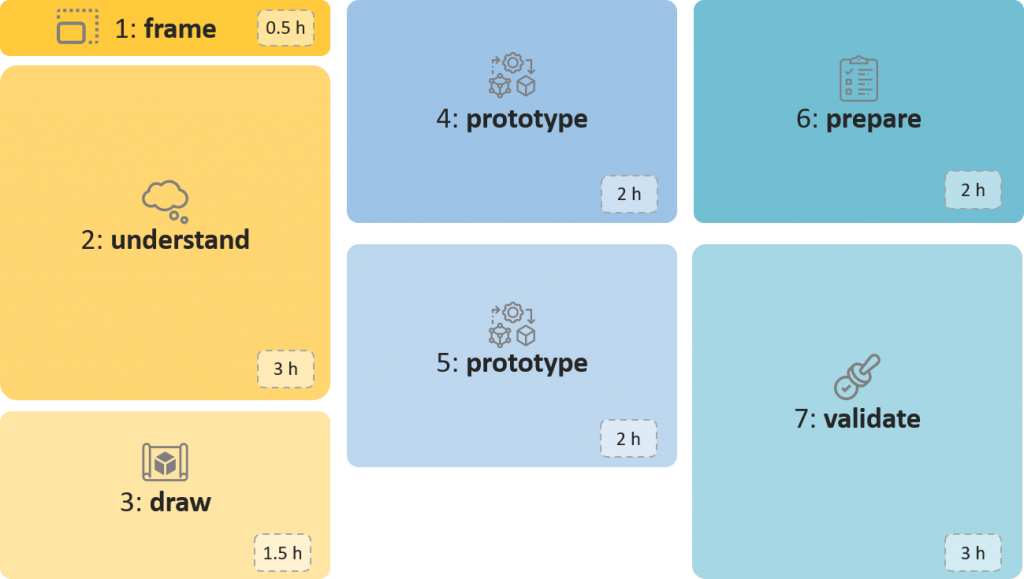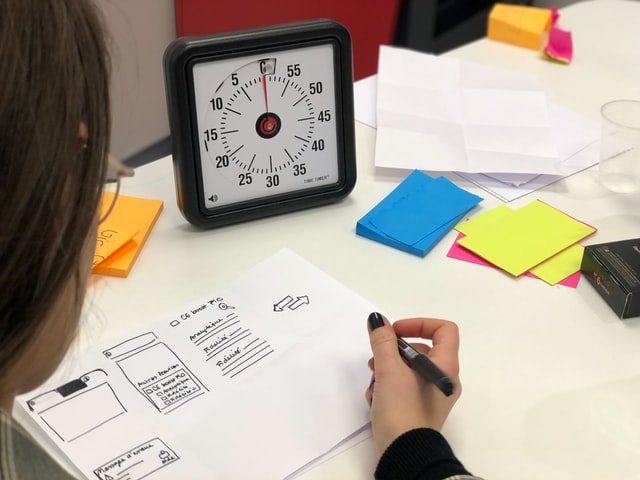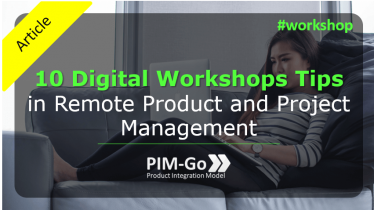How to Run a Design Sprint Under 3 days?
Welcome to #LeanDesignSprint
Imagine you’re in charge of shaping the future direction of a critical product. Times are uncertain and the mission is complex. You require the participation of key stakeholders in a multi-day Design Sprint workshop and the answer is….
“Sorry, I just don’t have the time…”
In other scenarios, they may worry about the cost or, perhaps, the team just doesn’t have the know-how to run the process confidently.
What would you do?
Photo by Bonneval Sebastien on Unsplash
. . .
A Bit of Context
In the last decade, Design Sprint has gained momentum, especially after Jake Knapp’s bestseller book “Sprint”, based on his experiences at Google Ventures. It defined a 5-day process having very clear phases: Map, Sketch, Decide, Prototype and Test.
The beauty (and value) of the process is its practicality. You have all the required techniques timeboxed for each day, following some sort of a recipe. The book clearly explains all the different scenarios and how to apply the techniques effectively. Many resources are freely available on the internet.
But one challenge remained.
It may be feasible to block the agenda of relevant startup stakeholders, but when working in larger organizations this can be tough.
To solve this, other authors offered some creative and interesting alternatives, such as:
– Compact the process to 4 or 3 days;
– Shorten the Days, leaving some space for distressing ordinary work participants may have, or perhaps;
– Spread it out, creating some space between the workshop days.
Following this path, additional versions such as Design Sprint 2.0 and 3.0 were structured.
They are all valid and solve many practical problems.
The 5-day Design Sprint or its alternatives may be a perfect match with your company’s culture, needs and available resources.
But not in all cases.

What is Lean Design Sprint (LDS)?
What is presented here comes from real practice, as it was run successfully in various teams. As it worked for them, it may also work for you.
But it is not the ONLY solution. It is ONE good solution to the existing toolkit of excellent alternatives.
So what is Lean Design Sprint?
“Lean Design Sprint is a process that can be run under 3 days.
It is compact, spread in 7 short sessions that can be perfectly run remotely.”
As indicated by its name, the process is based on three pillars:
- Lean: it is compact, focused on reducing waste (i.e., time & money);
- Design: it is focused on creating a solution, deriving from Design Thinking and Design Sprint approaches;
- Sprint: it runs in iterations, just as a Sprint in the Scrum framework.
And how is it different?
- It is based on sessions, not days. Spread it out to better fit your participants’ needs;
- It doesn’t take full days, leaving space for the participants to attend to some urgent work;
- It uses a specific, but flexible, set of techniques, which partly differs from traditional DS approaches.
. . .
How is LDS Structured?
Slightly differently from traditional Design Sprint methods, Lean Design Sprint has 7 sessions:


Here is where the challenge emerges
Your challenge might be about a usability issue, a new process or business model, a software solution, or related to an evidence-based investigation, or similar. Whatever it is, before you start out, make sure to set the scene and mark the boundaries of the challenge you want to address. Your high-level description is important for you to clear your thoughts and to get the people who will participate in the next steps rallied behind a common goal.
This part is not limited to the team of actual doers who will actually tackle the challenge in the next steps. Your target audience at this stage is anyone who is curious to listen, anyone who can make the time.
Taking the time to shed light on the challenge from different perspectives can be done by one person, for example the decider, or a team of people. This can take just 5 to 20 minutes or about an hour. Keep this part short, the real effort is in the preparation that can take days or weeks to complete.

Time to deep-dive and create a common understanding of the challenge
With the framing session behind you, this is the start of the actual Lean Design Sprint. Here you want to make sure that the core team is present. The core team consists of the people who can drive things forward in terms of subject matter expertise, providing the visualization and design skills, and whatever is needed to cover logistics such as finding the people to test your prototype(s) and to organize the space and time required for that.
This step brings together the most diverse, fast-paced and initially intensive set of activities. This is the time to take up the thread from the framing session, and to dive deeper into the various areas of concern that need to be addressed to tackle the challenge. Here you want to close knowledge gaps and reiterate the direction of where the prototyping activities need to go to devise a successful set of tests with real end users.
At the end of this step, the core team will be confident enough that they indeed address a set of goals they agree on, to have gained clarity on what facts and assumptions about the challenge exist, to have brought to the fore any questions that need to be answered, and to gain a first glimpse of what the prototype(s) will test.
The techniques applied in this step will have established clarity on the specific world in which the people act for who you aim to design.

The fun part: sketch, discuss, learn, sketch, discuss, learn, sketch…
Designers live and breathe this part. But the real magic lies in encouraging and inspiring the participants in the core team who would say that they “cannot draw” to actually express their ideas in ways other than spoken and/or written words. We are looking at simple sketches, not refined pieces of art that qualify for a public exhibition. We are looking at condensing ideas in a visual form that are otherwise too laborious to describe in words. We want to depart from creating slide decks that more often than not fail to generate interest and create impact.
At this step be as simple as you want to be or as sophisticated as you can afford. A pencil or pen and a sheet of paper will do to produce a set of flat black stick figures that show something that you need to elaborate on to help others understand what you mean. You could simply use the shapes and drawing features in your preferred slide deck software by moving beyond bullet-point lists. Or you can go straight to using web-based graphic design tools that designers use to create illustrations, artwork, simple flat or interactive wireframes, and so on. You won’t be able to overdo this step as you have only ten minutes to complete it.
Whatever the medium is that people use at this step, make sure that you get a good set of contributions that you go and discuss in turn. This will give people to fill in the gaps that the drawings leave inevitably. Soon, you will identify some neat ideas, you will be surprised about what people come up with, and you will start to notice patterns that allow you to define commonalities and outliers or unique details.
At the end of this step, the core team will be able to generate a synthesized master sketch that brings together the best ideas from across the various individual drawings. If you can come up with more than one master sketch, even better. This means you can, if you have the capacity, embark on building more than one prototype, as the master sketch that emerged from this step will be utilized as a lean blueprint for the next step.

Getting the bits and pieces together
At this step the team knows what to do to build a mockup or prototype or high-level proof of concept to translate the ideas that were mulled over up to this point into concrete expressions that can be tested. This step will take up most of the time of the entire Lean Design Sprint. It is the core activity that has the potential to arrive at a genuine point of difference to what people assumed to be possible so far.
This new stage is still characterized by emerging insights, it is a nascent state, nothing is cut in stone, things still change. Actually, things still have to change, and they do based on structured and rigorous feedback that people in the team share with each other about the prototype(s) that crop up.
This step is going far beyond the contributions from the previous step. If your challenge is about a design need you want to make sure that the designers in your team who are proficient with graphic-design tools use those to unleash their full potential. If your challenge is about a new process or business model you want to make sure that the operational and/or strategic players in the team can get cracking. If your challenge is about a software solution, it will be wise to give your developers in the team the space to hack together a semi robust first mockup. If your challenge is data related, make sure your data scientist(s) are in the driver seat at this step.
At the end of this step, the core team will have “something” that is good enough to share with a controlled group of people. We keep the pace fast and geared toward continuous evaluation and validation. There is no need for trying to defend the prototypes. Forget about falling in love with half-cooked things at this stage. The learning continues through inviting more feedback. This is achieved through good preparation for gaining this feedback and by remaining open to letting go and potentially discarding the output from this step with regards to some detail, or in extreme cases, in its entirety.

Setting everything up for the main event
Logistics is key at this step. Already at the end of the Understanding step, you will have started to line up people, time slots, as well as the physical and/or virtual space in which you will meet your appreciated testers. But now it is crunch time. At this stage, you know what you have to show and what you want to validate. The activities required for effective validation are just not clearly defined yet. People are still too much steeped inside the mash of the previous steps.
This intermediate step is essential to bring all the hard work together in a way that people who were not involved can relate. As a result, you benefit from having a concise and clear guide to run a semi-structured interview that first sets the scene and then introduces the challenge. At its core, the approach will have to be steered toward the key questions you want to cover with the end users who are invited to help you with their feedback.
At the end of this step, the team is clear on what comes first, what next, and how to wrap things up so that the overall experience with the end users is well rounded. It is important that the validation session is courteous and future oriented in the sense that you want to potentially build on the relationship that will be established with the team and the end users in the following final step.

Feedback from the end users, where true learning happens
Congratulations, if you made it to this stage, then all the hard work the team delivered will be put on stage for a reality check. The user tests are happening and you got your feedback. You handed over your prototype(s) to the end users and you stepped back to listen, observe, find inspiration, realize where you have been going in the wrong direction, patting your own shoulder for being on the right path – all of this or some of this you will have experienced.
And with everything in the world of following a lean mindset, you will realize that there is no end to the journey. You are in the midst of continuous discovery, continuous design, continuous development, continuous testing, continuous integration, continuous deployment and continuous improvement. Your activities are geared toward falsifying wrong assumptions. You eliminate waste, you safeguard yourself against verifying things that don’t hold.
. . .
To Wrap Up
After Jake Knapp’s watershed book, great minds have been working on hacking Design Sprint to make it better fit companies’ needs.
The Lean Design Sprint is one brand new alternative, based on the concept of sessions that can be run under 3 days.
The Lean Design Sprint is especially useful for companies whose stakeholders have tight agendas and limited budget. It is structured to be particularly effective with multi-site teams working remotely or from home.
It’s a flexible and proven way to save time and money while validating creative solutions collaboratively.
Want to know more about Lean Design Sprint? Join our free webinar on Jan 14th, 2021. We’ll run an end-to-end example with tons of valuable takeaways.
Wish you great deliveries.
Alvaro Junqueira e Stefan Sohnchen




